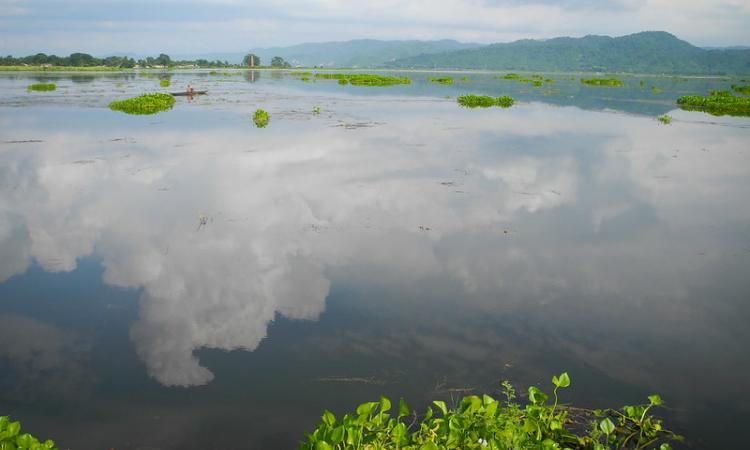
What is Ramsar Convention and what is its mission?
The Convention on Wetlands of International Importance, more commonly known as the Ramsar Convention, is an international agreement promoting the conservation and wise use of wetlands. It is the only global treaty to focus on a single ecosystem. The treaty was negotiated through the 1960s by countries and non - governmental organisations concerned about the increasing loss and degradation of wetland habitat for migratory waterbirds. The Convention was adopted in the Iranian city of Ramsar in 1971 and came into force in 1975.
The Ramsar Convention as of 04.11.2019 has 171 Contracting Parties (member countries). Under the “three pillars” of the Convention, the Contracting Parties commit to:
- work towards the wise use of all their wetlands;
- designate suitable wetlands for the list of Wetlands of International Importance (the “Ramsar List”) and ensure their effective management;
- cooperate internationally on transboundary wetlands, shared wetland systems and shared species.
How the Contracting Parties implement the Convention on Wetlands in their territories?
The Contracting Parties implement the Convention on Wetlands in their territories and collaborate on shared projects. The government agency responsible for its national application is known as the country’s Administrative Authority. This agency appoints a National Focal Point to coordinate the national implementation and act as the daily contact point.
Every three years the Parties meet at the Conference of the Contracting Parties (the COP), where they adopt decisions to administer the Convention and guide its implementation. Between the COPs, the Parties are represented by the Standing Committee, which meets yearly. The Standing Committee is guided by the framework of the decisions made by the COP.
The scope and focus of the Convention’s work are coordinated by means of a Strategic Plan and associated work plans which set out priority objectives and the actions expected or requested of the various bodies of the Convention.
What are the criteria to identify the Wetlands of International Importance?
There are nine criteria for identifying Wetlands of International Importance. These criteria are provided in the table below:
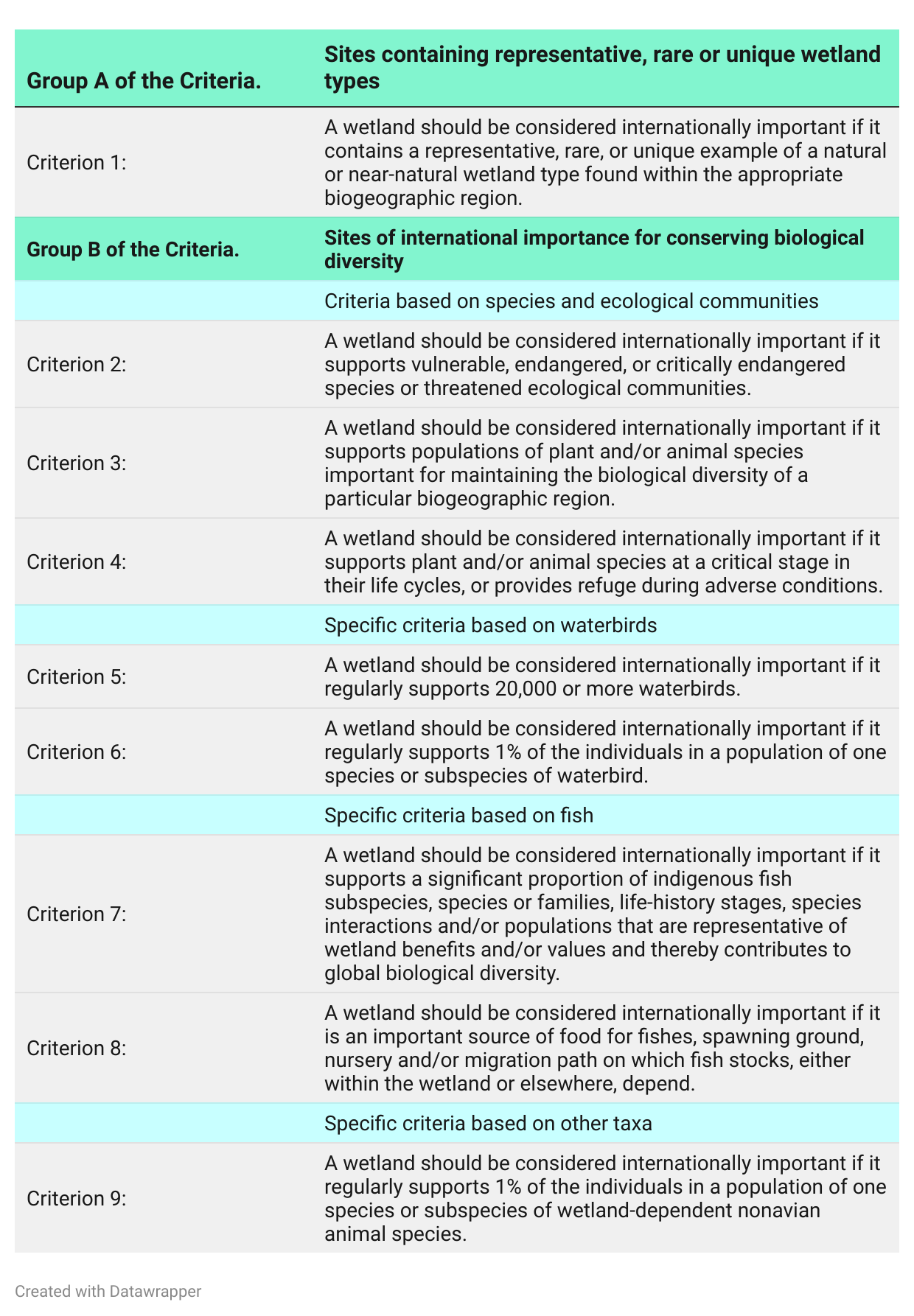
How many Ramsar sites are there around the world?
There are over 2,400 Ramsar sites around the world with most sites being in the United Kingdom and Mexico. The largest area under the Convention protection is in Bolivia with 148,000 square km area designated. Canada, Chad, Congo and the Russian Federation have also each designated over 100,000 square kilometres.
The world’s first site was the Cobourg Peninsula in Australia, designated in 1974. The largest sites are Rio Negro in Brazil (120,000 square kilometres), and Ngiri-Tumba-Maindombe in the Democratic Republic of Congo and Queen Maud Gulf in Canada; these sites each cover over 60,000 square km.
Access the site summaries by country here.
When did the convention enter into force in India?
The convention entered into force in India on February 1, 1982. Chilika Lake in Orissa and Keoladeo National Park in Rajasthan were the first two sites designated by the convention.
How many Ramsar sites does India have and what are their names?
India currently has 49 sites (as on February, 2022) designated as Wetlands of International Importance (Ramsar Sites), with a total surface area of 1,090,636 hectares. The names of these wetlands with the year of designation and the area they occupy in hectares are provided in the table below. Also, look at these sites on the map of India here.
What is the year-wise distribution of the Ramsar sites designated in India?
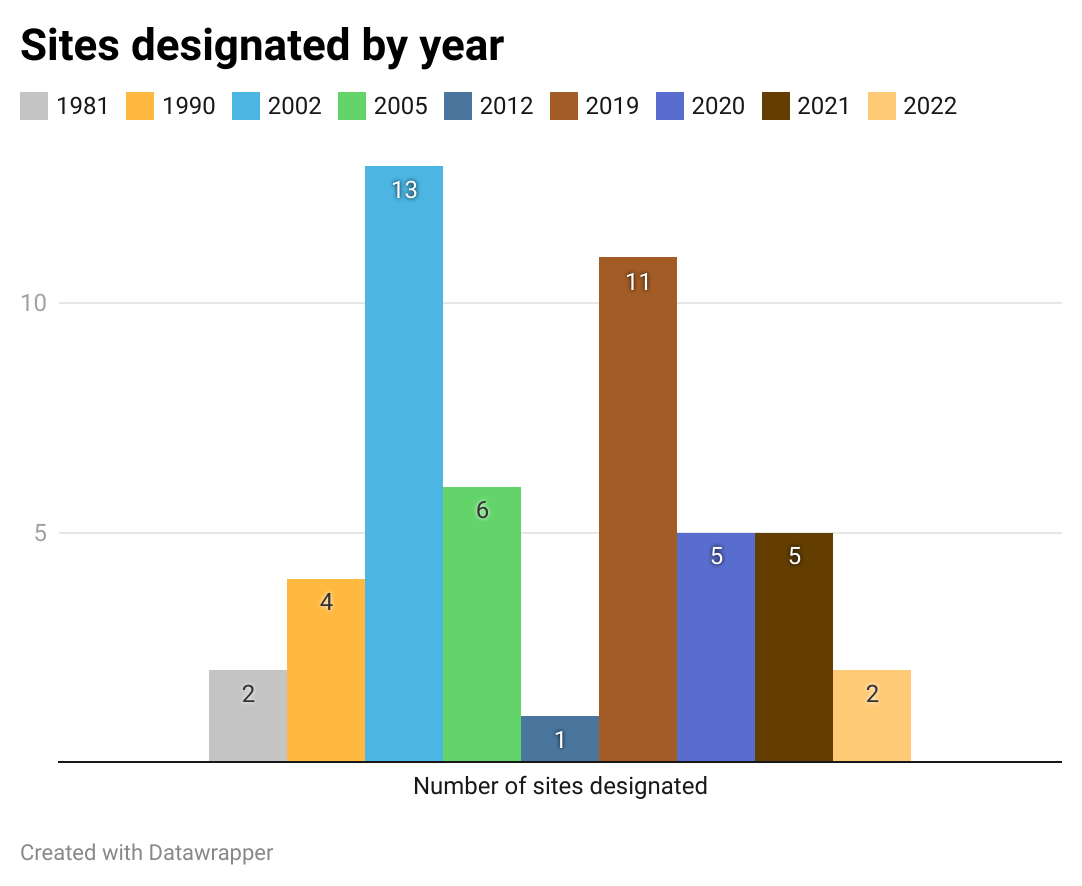 With the designation of 13 sites, the maximum number of recognition of Ramsar sites occurred in the year 2002, followed by 2019, which observed the designation of 11 sites. In 2002, Kolleru Lake in Andhra Pradesh and Bhitarkanika Mangroves in Odisha were the two largest sites designated, while Sunderban Wetland in West Bengal was the largest in 2019. In the wetland history of India, it is in 2019, 2020, 2021 and 2022 alone that the designation of Ramsar sites took place during the consecutive years. In 2021, two wetland sites in Haryana were recognised as Ramsar sites, the first time for Haryana.
With the designation of 13 sites, the maximum number of recognition of Ramsar sites occurred in the year 2002, followed by 2019, which observed the designation of 11 sites. In 2002, Kolleru Lake in Andhra Pradesh and Bhitarkanika Mangroves in Odisha were the two largest sites designated, while Sunderban Wetland in West Bengal was the largest in 2019. In the wetland history of India, it is in 2019, 2020, 2021 and 2022 alone that the designation of Ramsar sites took place during the consecutive years. In 2021, two wetland sites in Haryana were recognised as Ramsar sites, the first time for Haryana.
In which states are these Ramsar sites are located?
20 out of 28 states and union territories in India have the designated Ramsar sites.
By the number of sites, maximum of the Ramsar sites are in Uttar Pradesh , home to 10 sites. By area, West Bengal (having 4,35,500 hectares of sites) has the maximum area of Ramsar sites, while Tripura (having 240 hectares) and Uttarakhand (having 444 hectares) have the least area occupied by the Ramsar sites.
Although Uttar Pradesh has the maximum number of sites, they occupy only 39,565 hectares of area in the state. On the other hand, only two sites-- Sunderban Wetlands and East Calcutta Wetlands-- occupy a huge area of wetland in West Bengal.
Is there any distribution of these sites based on the type of wetlands?
The definition of wetlands included in the Convention is deliberately broad, encompassing "areas of marshes, fen, peatland or water, whether natural or artificial, permanent or temporary, with water that is flowing or static, fresh, brackish or salty, including areas of marine water the depth of which at low tide does not exceed six metres". It may also include riparian and coastal zones adjacent to the wetlands, and islands or bodies of marine water deeper than six meters at low tide lying within the wetlands. These characteristics form the basis for classifying different wetland types contained in the `Ramsar Classification of Wetland Type'.
The Ramsar Classification of Wetland Type currently in use, was adopted by the Conference of the Parties in 1990. It divides wetlands into three main categories, namely: marine and coastal wetlands, inland wetlands, and man-made wetlands. The categories have further subdivisions which gives a total of 40 wetland types (see the table).
The Ramsar classification was initially developed as a simple tool for describing Ramsar sites. It also serves as a broad framework to aid rapid identification of the main wetland habitats represented at each site, and to provide units for mapping and comparability of concepts and terms in national or regional wetland inventory. It should be stressed that the Ramsar classification is for use at a broad, global scale and it has always been recognised that more detailed, but compatible systems may be needed at regional or national levels for complex integrated planning activities.
Based on the wetland types, out of the 49 Ramsar sites, 37 are inland wetlands, while 23 are human-made and eight wetlands are marine or coastal wetlands. The map given below shows the distribution of these wetlands based on the type. In many wetlands the type overlaps like Kolleru Lake in Andhra Pradesh is an inland, marine and a human-made wetland.
Based on the criteria, how are these Ramsar sites distributed?
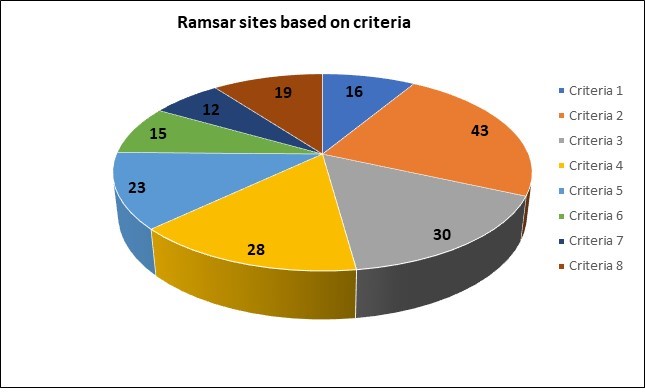 The Ramsar sites in India are distributed in eight criteria with none of the sites fulfilling criterion 9, which pertains to non-avian wetland-dependent taxa, although sites such as Loktak fulfill this criterion. The majority of these sites fall under criterion 2 as per which, a wetland should be considered internationally important if it supports vulnerable, endangered, or critically endangered species or threatened ecological communities followed by criterion 3 and criterion 4. While 36 sites fall under the criteria specific to water birds that is Criteria 5 & 6, 29 sites fall under the criteria specific to fish (Criteria 7 & 8). Check this table out to see which Ramsar site fulfills which criteria.
The Ramsar sites in India are distributed in eight criteria with none of the sites fulfilling criterion 9, which pertains to non-avian wetland-dependent taxa, although sites such as Loktak fulfill this criterion. The majority of these sites fall under criterion 2 as per which, a wetland should be considered internationally important if it supports vulnerable, endangered, or critically endangered species or threatened ecological communities followed by criterion 3 and criterion 4. While 36 sites fall under the criteria specific to water birds that is Criteria 5 & 6, 29 sites fall under the criteria specific to fish (Criteria 7 & 8). Check this table out to see which Ramsar site fulfills which criteria.
What ecosystem services do these Ramsar sites provide?
Wetlands provide a range of benefits and functions for people and the environment. The multifunctional nature of wetlands has been conceptualised in the Millennium Ecosystem Assessment’s ‘wetland ecosystem services’, which stresses how they contribute to human well-being and poverty alleviation.
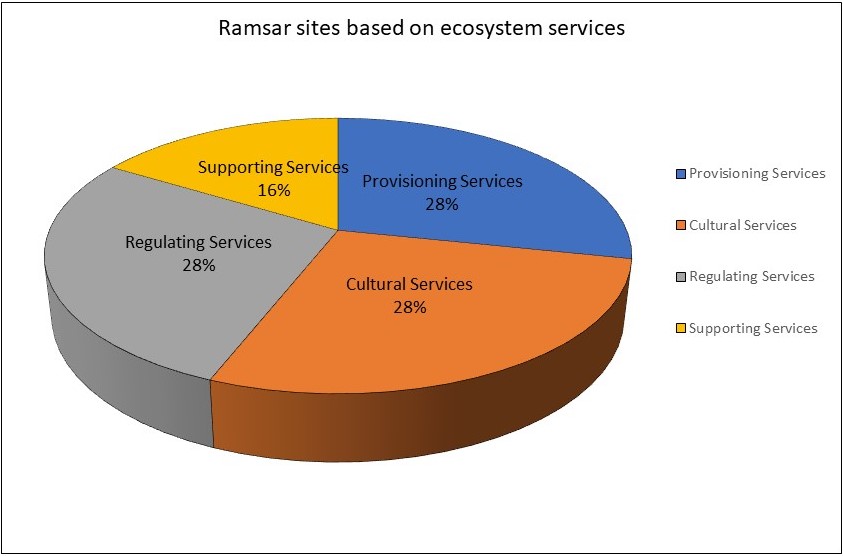 These services are divided into four categories broadly—provisioning, regulating, cultural and supporting. While provisioning services have direct economic value to people, regulating and support services in general help maintain environmental functions which are of indirect benefit to communities. The cultural ecosystem services with respect to the spiritual, recreational, and aesthetic values that are prized highly among many societies. Meanwhile, the intrinsic biodiversity and ecological value of wetlands continue to be a key element in the discourse, driving the development of management policy for these areas. The examples of these services are given in the table below.
These services are divided into four categories broadly—provisioning, regulating, cultural and supporting. While provisioning services have direct economic value to people, regulating and support services in general help maintain environmental functions which are of indirect benefit to communities. The cultural ecosystem services with respect to the spiritual, recreational, and aesthetic values that are prized highly among many societies. Meanwhile, the intrinsic biodiversity and ecological value of wetlands continue to be a key element in the discourse, driving the development of management policy for these areas. The examples of these services are given in the table below.
| Services | Examples |
|---|---|
| Provisioning | Food, freshwater, fibre, fuel, medicinal, genetic |
| Regulating | Climate regulation, water regulation (hydrological flows), water purification and waste treatment, erosion control, natural hazard protection, pollination |
| Cultural | Spiritual and inspirational, Recreational, Aesthetic, Educational |
| Supporting | Soil formation, nutrient cycling |
However, not all wetlands support the full range of ecosystem services. Specific services are associated with particular types of wetland in specific ecological and geographical settings. Because of the complexity of natural systems, it is often difficult to predict the exact nature and the magnitude of services that any wetland provides. In India, most of the Ramsar sites provide provisioning, regulating and cultural services while a few, only a 14 percent, provide supporting services. Although the services are not specific to a site, but each service is primary to a Ramsar site. View this map to know the primary ecosystem service, a Ramsar site provides.
What are the threats to these sites?
Wetlands are among the most threatened ecosystems in the world. These ecosystems encounter both natural and human threats. The natural threats arise from inevitable naturally occurred processes that have the potential to damage wetlands like flooding, land subsidence, soil erosion, and drought.
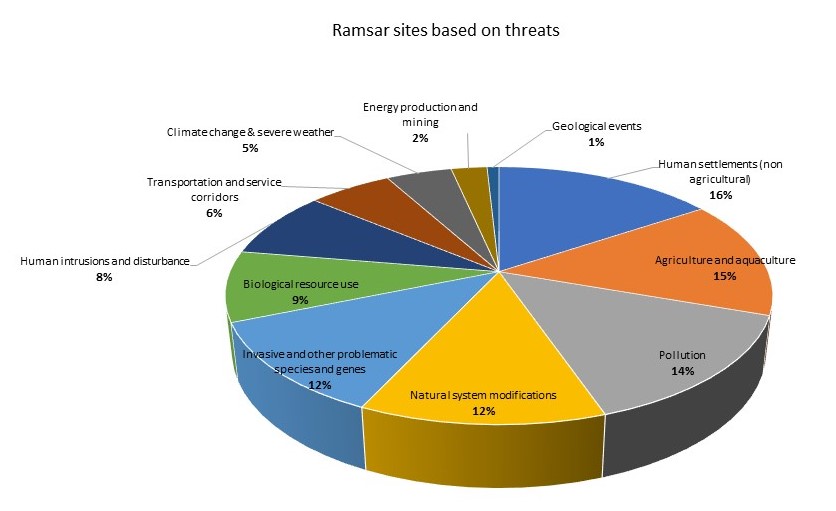 To expand their economic benefits, humans have extensively reclaimed natural wetlands, and thus pose a threat to the existence of wetlands. Land conversion, discharge of hazardous wastes, unsustainable ecotourism, the introduction of alien species are some of the human threats to wetlands.
To expand their economic benefits, humans have extensively reclaimed natural wetlands, and thus pose a threat to the existence of wetlands. Land conversion, discharge of hazardous wastes, unsustainable ecotourism, the introduction of alien species are some of the human threats to wetlands.
Human settlements, agriculture and aquaculture, pollution and natural system modification mostly threaten the Ramsar sites in India. The other threats to these sites include invasive and other problematic species and genes; biological resource use; human intrusions and disturbance; transportation and service corridors; climate change and severe weather; energy production and mining; and geological events.
It is in response to these threats to the ecological character of wetlands that the Ramsar Convention was formed. The Convention has laid guidance to Contracting Parties on the management of Ramsar Sites, in addition to its guidance on the wise use of all wetlands. The inclusion of a wetland in the List embodies the government’s commitment to take the steps necessary to ensure that its ecological character is maintained.
Are there any wetland management plans for the Ramsar sites in India?
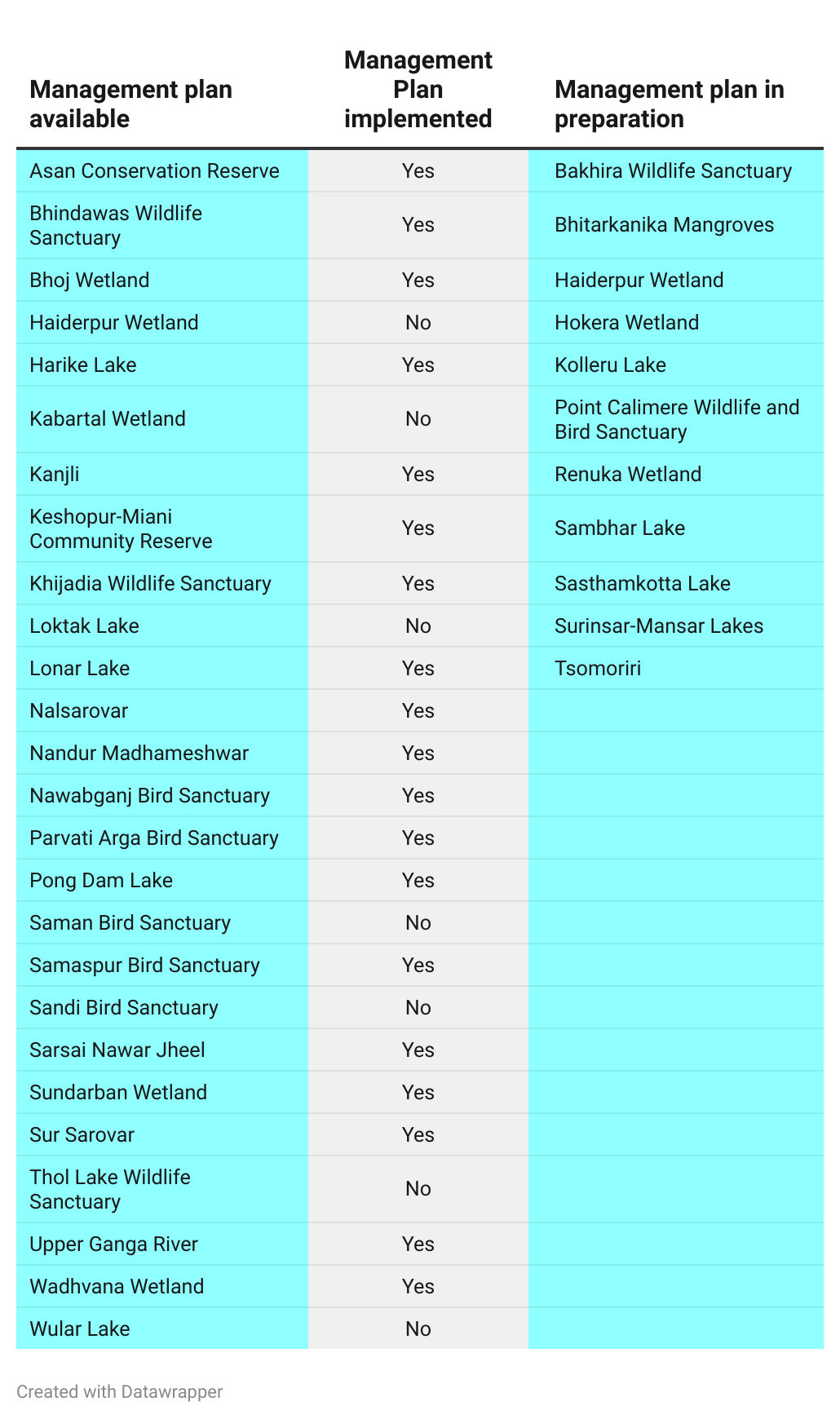 A clear management plan is essential to guide all aspects of the operation, administration and wise use of the Ramsar site. The plan must help ensure that it is managed to retain or improve those essential ecological and hydrological functions which provide its benefits and services. The plan should cover the current status of the site, integrate local and indigenous knowledge, establish goals and objectives for the future, explain how those goals and objectives are prioritised and how they will be met.
A clear management plan is essential to guide all aspects of the operation, administration and wise use of the Ramsar site. The plan must help ensure that it is managed to retain or improve those essential ecological and hydrological functions which provide its benefits and services. The plan should cover the current status of the site, integrate local and indigenous knowledge, establish goals and objectives for the future, explain how those goals and objectives are prioritised and how they will be met.
For 26 of the 49 Ramsar sites, the management plan is available while the management plans for 11 sites are under preparation. Out of the 26 Ramsar sites for which the management plans are available, the management plans have been implemented for 19 of these sites. The names of these sites are provided in the table.
Is there any other designation given to these sites?
Yes. Keoladeo National Park and Loktak Lake are listed in Montreux record, which is a register of wetland sites on the List of Wetlands of International Importance where changes in ecological character have occurred, are occurring, or are likely to occur as a result of technological developments, pollution or other human interference. It is maintained as part of the Ramsar List.
In 1990, a technical assistance mechanism, the Ramsar Advisory Mission was adopted with an aim to provide assistance to developed and developing countries alike in solving the problems or threats that make inclusion in the Montreux Record necessary. But over the years the missions have tended to become more formal and frequently more detailed, involving multi-disciplinary teams, sometimes in collaboration with other bodies such as the World Heritage Convention, the World Conservation Union (IUCN), and the UNESCO Man and the Biosphere Programme. Keoladeo National Park and Chilka lake are the two Ramsar sites in India that are part of the Mission. The Keoladeo National Park along with Sunderban Wetland are also a World Heritage site, while the latter is a UNESCO Biosphere Reserve as well.
View the factsheets of Ramsar Sites of India prepared by the Wetland Division of the Ministry of Environment, Forest and Climate Change.